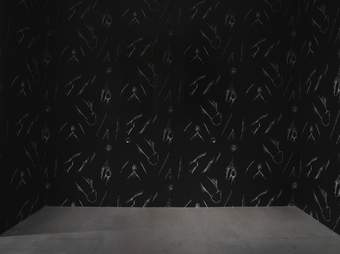
Robert Gober Installation Tate Liverpool 1993
This exhibition is Robert Gober's first solo exhibition in Britain. It brings together a number of works made in the last ten years, combining 'multiple' objects, singular sculptures and two room installations. These are works from a journey which is at once aesthetic and personal, political and poetic.
As a young artist in New York in the 1970s Gober worked as an artist's assistant and carpenter, building complicated, shaped stretchers for Elizabeth Murray, and crafting accurately proportioned and detailed dolls' houses to make money. His father was a factory worker and an amateur craftsman who built the family house himself.
Gober worked with a multi-media performance group for a time, commenced a lengthy psychoanalysis, and painted, making a series of images on one small board which were transformed, day by day, one into another. A cropped human torso became the subject of numerous versions. As Gober painted over each image, he took slides of them, and held an exhibition of these 'lost' images, Slides of a Changing Painting, in 1984. These erased paintings, the earliest works in the exhibition, are projected onto a screen in the riverside gallery.
By 1984, Gober had also begun making sculpture, and was identified with a new wave of American artists, a loose grouping which included Jeff Koons, Haim Steinbach and Ashley Bickerton. While these artists made works in which real objects were borrowed from the world of consumerism and presented in the gallery with varying degrees of sarcasm, cynicism and art-world careerism (delivering the kind of art the Reagan years deserved - consumerist, glitzy and superficial), Gober's sculptures were deceptively handcrafted objects, derived from the form of the humble studio sink. These painted plaster sinks looked like the real thing: grim reminders of dirt and squalor as much as of hygiene and personal cleanliness; of the morgue sluicing trough as much as of the washroom hand-basin.
One of the two rooms made by Robert Gober is covered with his Male and Female Genital Wallpaper, punctured again with sink drains, this time cast in pewter from a hand-made clay version. The plugholes imply drainage, the extraction of taboos or transgressive desires, body odours, and the ectoplasm of the unconscious. They drain the room of unspeakable thoughts: equally, they function as portholes or keyholes, through which one might be observed. The wallpaper is as much a depiction of hysterical projection, hallucinated sexual fantasy, as it is interior decoration.
People get married, walk in the woods, make love, munch donuts, and sit around in their comfortable homes. Meanwhile, we wrestle with sex, make combat with our memories and desires, and try to hold on to our utopian dreams of happy families, clean living and social justice. As the AIDS pandemic spreads, and social justice is seen not to be done, everywhere, at all times, and as fragile social values fray apart in the West, Robert Gober's art seems particularly apposite and necessary. He reminds us, of ourselves, and the way we, live now, and the guilt we carry with us.

